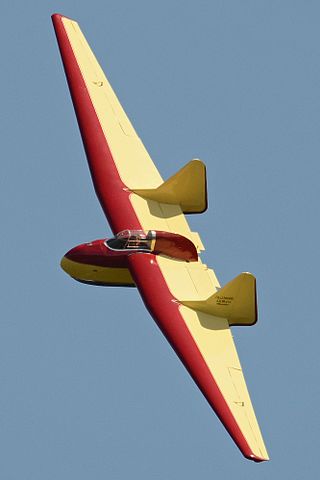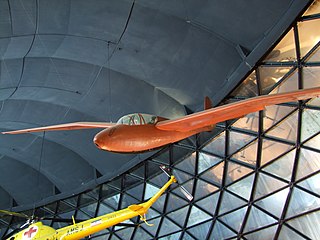
The Göppingen Gö 4 or Goevier is a German sailplane of the late 1930s used for training pilots. Its most notable features include side-by-side seating and dual controls, making the plane ideal for use as a trainer. It boasted average performance, compared to other gliders of the day, and was advertised as making the process of learning to fly sailplanes easier.

The Schleicher K 8 is a single-seat glider designed by Rudolf Kaiser and built by the Alexander Schleicher company of Germany.

The Akaflieg Stuttgart fs24, nicknamed Phönix, was a glider designed and built in West Germany from 1951.

The Lo-100 is an aerobatic glider of classic wood and fabric construction well suited to amateur building methods. The designation Lo was bestowed by the designer Alfred Vogt in memory of his brother Lothar Vogt, with whom he had developed the predecessor model Lo-105 Zwergreiher. The first flight of the prototype took place in 1952 at the Klippeneck. An example is on display at the Gliding Heritage Centre.

The Aer-Pegaso M-100 was a single-seat glider designed and built in Italy from 1957.

The Fauvel AV.36 was a single-seat tailless glider designed in France in the 1950s by Charles Fauvel. Although the "AV" in AV.36 stands for Aile Volante, it was not a true flying wing: it featured two large fins mounted on stubby tailbooms extending back from the wing's trailing edge, and accommodated the pilot within a stubby fuselage. The aircraft was designed to be quickly disassembled for road transport, with the nose detaching, and the fins able to fold back against the trailing edge of the wing. A refined version with a slightly longer wingspan, the AV.361 was introduced in 1960.
The Fauvel AV.45 was an unorthodox motor glider produced in France in the 1960s and 1970s. Like other Charles Fauvel designs, it was a tailless aircraft, in this case inspired by the work that German firms had done on producing motorised versions of his AV.36 design. The prototype of the AV.45 was an extensively modified AV.36 powered by a Nelson H-59 two-stroke engine. AV.45s have been built with a number of other engines, however, including at least one aircraft powered by a small turbojet. Falconar marketed the plans in the 1970s.

The PIK-5 was a training glider produced in Finland in the 1940s, and 1950s, equipping the country's gliding clubs with an aircraft greater in performance than primary gliders but less than competition sailplanes.

The SZD-12 Mucha 100 was a single-seat glider aircraft that was designed and built in Poland from 1953.

The SZD-17X Jaskółka L was a single-seat high-performance competition glider designed and built in Poland at Szybowcowy Zakład Doświadczalny in Bielsko-Biała in 1955.

The Scheibe Bergfalke is a German glider designed by Egon Scheibe as a post-World War II development of the Akaflieg München Mü13 produced before and during the war.

The Slingsby Type 45 Swallow was designed as a club sailplane of reasonable performance and price. One of the most successful of Slingsby's gliders in sales terms, over 100 had been built when production was ended by a 1968 factory fire.

The Johnson RHJ-6 Adastra was an American mid-wing, two-seat glider that was designed and constructed by Dick Johnson and first flown on 3 April 1960.

The Matteson M-1 was an American high-wing, single-seat, FAI Open Class glider that was designed and built by Fred Matteson of Palo Alto, California and Alfred Vogt of Schempp-Hirth.

The Rubik R-26 Góbé is a family of Hungarian shoulder-wing, two-seat training gliders that was designed by Ernő Rubik Sr., and produced by Auto-Aero. After its introduction the R-26 Góbé became the de facto training glider type in Hungary and is still used by many clubs for basic instruction.

The Hütter Hü 17, is a German high-wing, strut-braced, single-seat, utility training glider that was designed by brothers Ulrich Hütter and Wolfgang Hütter in the 1930s.
The Vogt Lo-150 is a West German high-wing, single seat glider that was designed by Alfred Vogt and produced by the Wolf Hirth Company.

The HKS-1 was a German 19 19 m (62.3 ft) span high performance two seat sailplane, designed around 1950 to use recent advances in laminar flow airfoils. To avoid premature transition from laminar flow caused by surface interruptions, the HKS-1 dispensed with hinged ailerons, flaps and spoilers and replaced them with a flexible trailing edge. Two were built, setting several records.

The Ikarus Košava is a two-seat sailplane designed and built in Yugoslavia in the early 1950s. It won the 1954 World Gliding Championships in the two seat category and came second in the same event two years later.

The Schleicher Ka-2 Rhönschwalbe is a tandem two-seat training glider designed and built in Germany, in 1952.




















